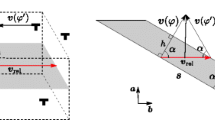Abstract
Typically, the analysis of high-temperature creep is based upon “diffusion-controlled processes”,i.e., establishing boundary conditions at certain “sinks” and then solving the diffusion equation to obtain the rate of mass transport and from this calculating the dislocation velocity. This automatically establishes a fixed value for the activation energy of the process, namely that for self-diffusion, and normally no other “activation parameter” is considered, although sometimes the activation volume has been considered and shown to be equivalent in several materials to that for self-diffusion. On the other hand, investigators of low-temperature creep typically invoke activation analysis, often without positing any specific mechanism, for the movement of the dislocation and consider the work done by the applied stress to decrease the required activation energy. These analysts then calculate activation energy, volume and area from their data and compare these with values expected for specific mechanisms. No real attempt at a synthesis of these two methods of analysis has been presented. We discuss here a specific model, namely the movement of a screw dislocation containing jogs, and perform the analysis both by the diffusion-control approach and by the activation analysis approach. In so doing we show specifically that certain restrictive assumptions concerning activation areas are implicit in the diffusion-control approach even though they are never dealt with explicitly. The techniques here can be applied to other mechanisms as well.
Similar content being viewed by others
References
H. Conrad:J. Metals, 1964, vol. 16, p. 582.
J. C. M. Li:Dislocation Dynamics, 1968, Mc-Graw-Hill, New York, p. 87.
G. Schoeck:Phys. Status. Solidi, 1965, vol. 8, p. 499.
J. P. Hirth and W. D. Nix:Phys. Status. Solidi, 1969, vol. 35, p. 177.
F. A. Nichols:Mater. Sci. Eng., 1971, vol. 8, p. 108.
J. Weertman:Tram. ASM, 1968, vol. 61, p. 681.
C. R. Barrett and W. D. Nix:Acta Met., 1965, vol. 13, p. 1247.
W. J. Duffin and F. A. Nichols:Acta Met., 1970, vol. 18, p. 1121.
J. Friedet:Dislocations, 1964, Pergamon Press, London, p. 66.
J. P. Hirlh and J. Lothe:Theory of Dislocations, 1968, McGraw-Hill, New York, p. 540.
Ibid, pp. 537, 543.
Author information
Authors and Affiliations
Rights and permissions
About this article
Cite this article
Nichols, F.A. Dislocation-Activation analysis of diffusion-controlled creep processes. Metall Trans 5, 1967–1972 (1974). https://doi.org/10.1007/BF02644487
Received:
Published:
Issue Date:
DOI: https://doi.org/10.1007/BF02644487




